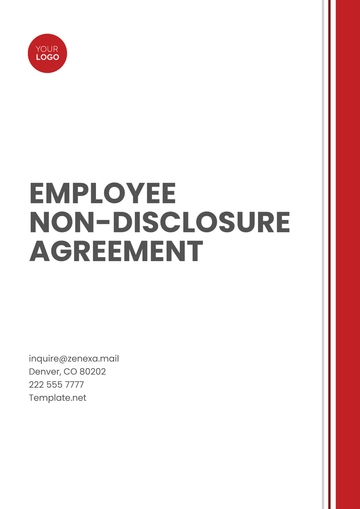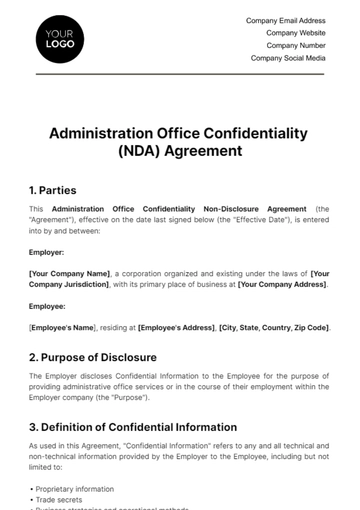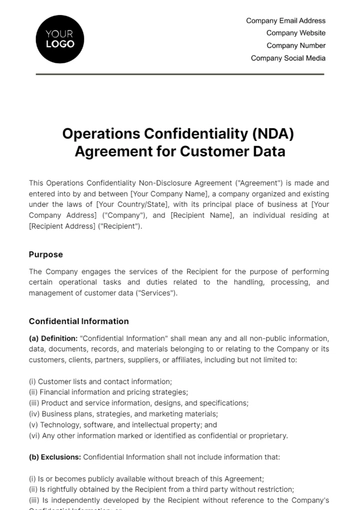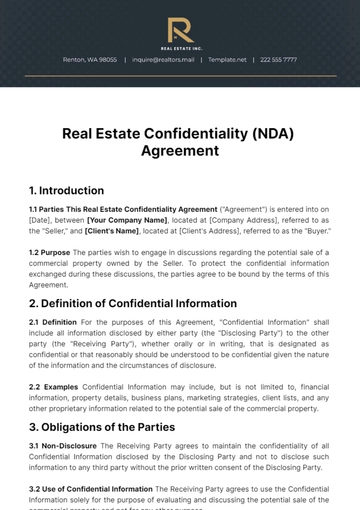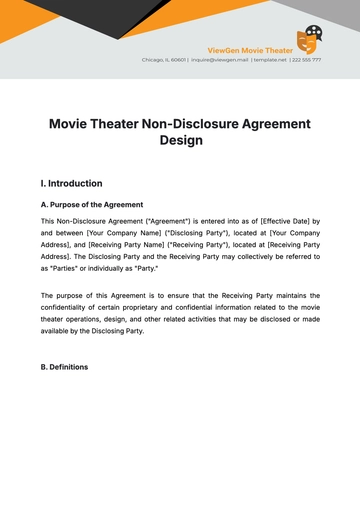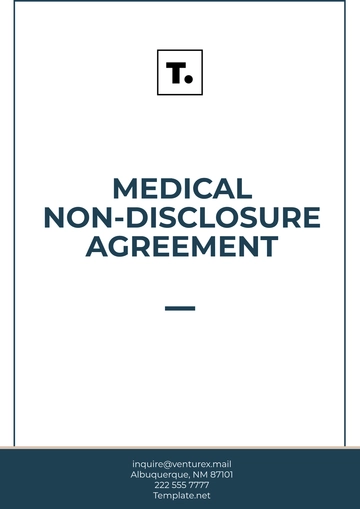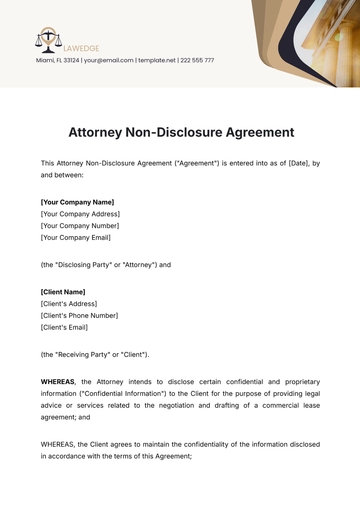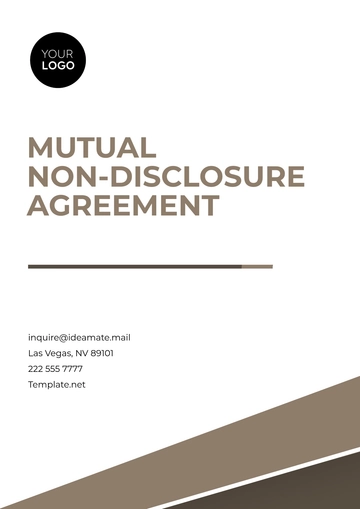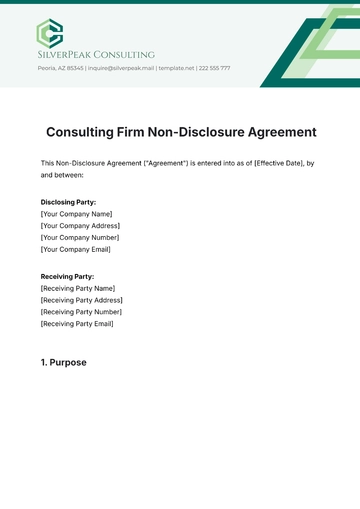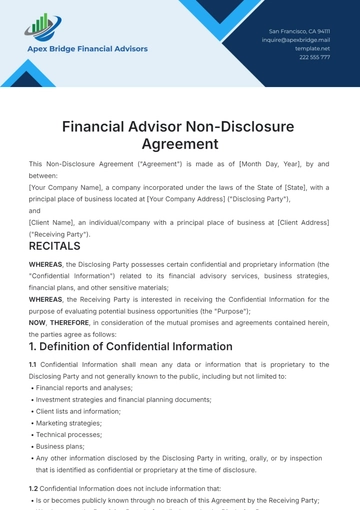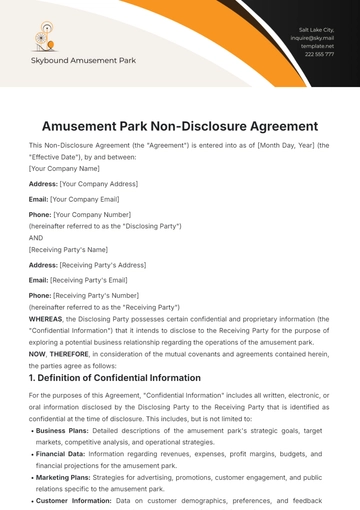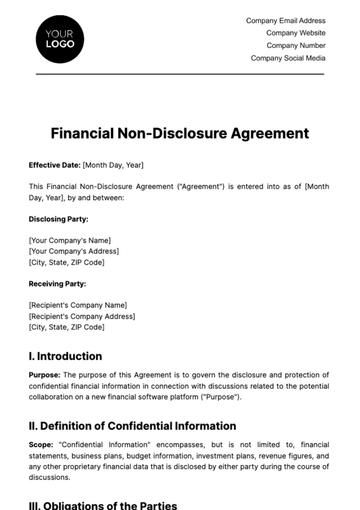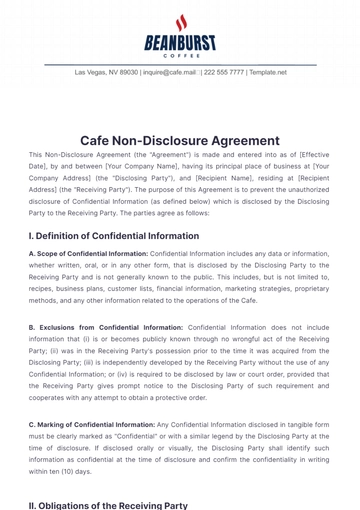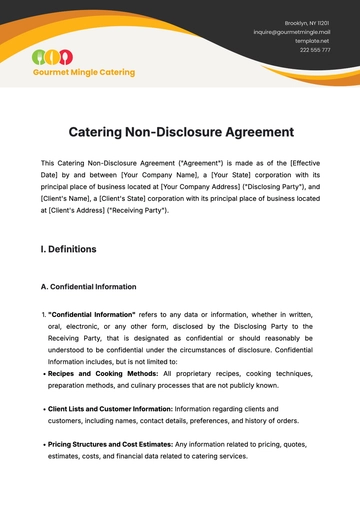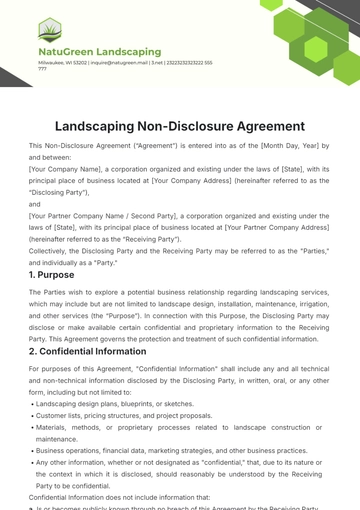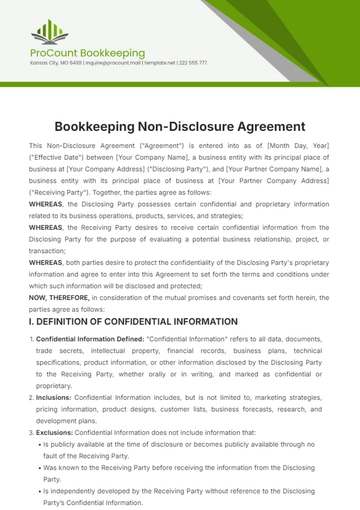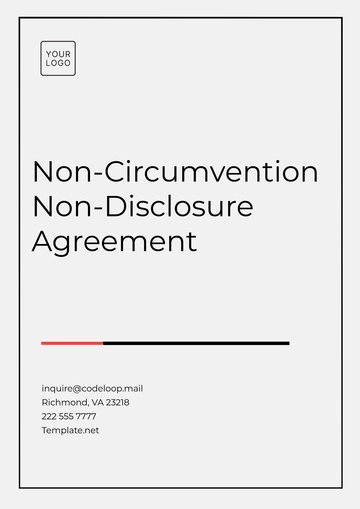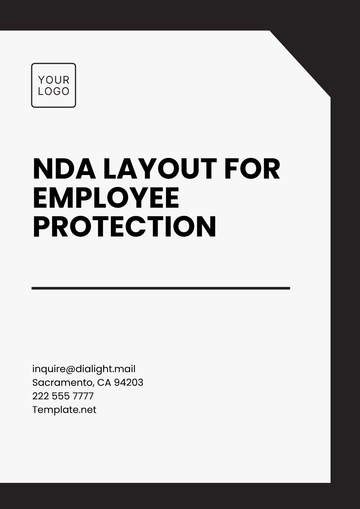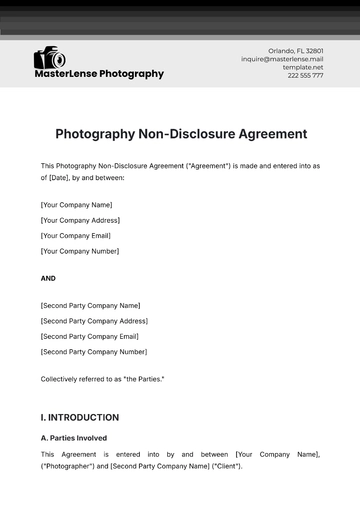Free Non Disclosure Agreement (NDA)

This Non-Disclosure Agreement (the "Agreement") is entered into this [EFFECTIVE DATE] by and between [Your Company Name], located at [Your Company Address], company number [Your Company Number], (referred to as "Party A") and [Party B Name], located at [Party B Address], company number [Party B Number], (referred to as "Party B").
1. PURPOSE
Party A and Party B, hereinafter referred to collectively as the "Parties", have expressed their interest in exploring potential business relationships that could benefit both entities. During this exploratory process, it may become necessary for both parties to disclose certain sensitive or proprietary information that is confidential. It is for this purpose that they have decided to enter into this Agreement, which has been specifically designed to afford protection against any unauthorized disclosure or misuse of this Confidential Information.
2. CONFIDENTIAL INFORMATION
The term "Confidential Information" is to be understood as encompassing any form of data or information that gets exchanged, communicated, or transferred between two or more entities, irrespective of the channel, medium, or mode in which this communication occurs. This can include but is not limited to, data communicated through written reports, verbal conversations, physical inspections, or examinations, and so on. A significant aspect of the term "Confidential Information" is that such data or information is expressly marked, classified, or designated as being "Confidential". This explicit labeling might also be done using equivalent or similar terms, expressions, or classifications like "Proprietary". Therefore, it is important to understand that any piece of data that bears these labels or designations is to be treated as, and corresponds with the meaning of, "Confidential Information".
3. NON-DISCLOSURE
The party who is receiving the information is providing assurances that it will exercise a degree of care and caution in safeguarding the confidentiality of the disclosed confidential information which is on par with the level of care it employs to protect its own similarly important information. However, this does not imply that the level of care will be less than what is reasonably expected to properly maintain the confidentiality of the information provided.
3.1 Legal Obligation: Non-disclosure agreements (NDAs) legally bind parties to maintain confidentiality. They ensure that sensitive information remains protected from unauthorized disclosure or use.
3.2 Mutual Understanding: NDAs establish a mutual understanding between parties regarding the treatment of confidential information. This helps build trust and facilitates open communication while safeguarding proprietary data.
3.3 Risk Mitigation: By outlining clear guidelines for handling confidential information, NDAs mitigate the risk of data breaches or misuse. They provide a framework for recourse in case of breaches, protecting the interests of both parties involved.
4. RETURN OF CONFIDENTIAL INFORMATION
Upon receiving a request from the disclosing party, the party who has received the confidential data will take either of the following actions as required: returning all the confidential information to the disclosing party or destroying the said data. Once the process of destruction is completed, the receiving party will provide a written confirmation to the disclosing party that the confidential data has been completely and successfully destroyed.
4.1 Return of Originals and Copies:
Upon the disclosing party's request, the receiving party agrees to promptly return all original documents and copies of Confidential Information, ensuring complete removal from their possession or promptly destroying them.
4.2 Certification of Destruction:
In compliance with the disclosing party's request, the receiving party will provide a written certification confirming the destruction of all Confidential Information, thereby ensuring no further access or potential misuse.
5. JURISDICTION
This Agreement will be governed and interpreted under the laws of the State, excluding any principles of conflicts of law. Should legal proceedings become necessary concerning this Agreement, they will be carried out within the jurisdiction of [Your State].
6. PERMITTED DISCLOSURE
6.1 The Parties, who are involved in this agreement, have mutually decided to disclose certain elements of Confidential Information to each other. This decision has been taken to explore and possibly foster mutual business relationships, which could prove beneficial for all parties involved.
6.2 The term "Confidential Information" can encompass a variety of elements and is not strictly limited in its definition. This may comprise of, but is certainly not restricted to, elements such as trade secrets and business plans. It could also involve detailed financial information or lists of customers. Furthermore, it can also include any other forms of proprietary information.
6.3 Both Parties involved in this agreement are in mutual understanding and agreement that they will not disclose any Confidential Information to any third party without obtaining prior written consent from the party that is disclosing the information. However, an exception to this rule exists in cases where there is a legal requirement to disclose such information.
7. TERMS
7.1 The official commencement of this Agreement is tied to the effective date, as explicitly mentioned within the provisions of the contract. Furthermore, the agreed-upon duration that the Agreement is expected to remain in effect would be a period that has been pre-determined and duly specified in precedent communications or documentation.
7.2 The stipulated terms of this Agreement confer the permission for termination by either the Party involved. However, it is strictly mandated that a formal written notice that communicates their desire and intention to discontinue or terminate the Agreement should be provided to the respective second party.
7.3 In the event of termination, both parties involved are obligated to quickly return or destroy every piece of Confidential Information that is currently in their possession. Additionally, they are required to confirm that these actions have been fully carried out through the submission of a written certification.
8. REMEDIES
Should there be a violation of any provisions or terms outlined in this Agreement, the party who has not committed the breach will have full rights to seek appropriate compensation through equitable relief. This may include but is not limited to injunctions and other similar protective court orders. Aside from these equitable remedies, the non-breaching party is also allowed to seek out any other legal options and remedies that are made available according to statutory law, common law, or any other recognized principles of equity.
8.1 Injunctive Relief: This remedy allows the non-breaching party to seek a court order requiring the breaching party to cease certain actions or fulfill specific obligations outlined in the agreement.
8.2 Specific Performance: In cases where monetary compensation is deemed insufficient, specific performance may be sought, compelling the breaching party to fulfill their contractual obligations as outlined in the agreement.
8.3 Compensatory Damages: The non-breaching party may seek monetary compensation to cover losses incurred as a result of the breach, aiming to restore them to the position they would have been in had the breach not occurred.
8.4 Liquidated Damages: Some agreements include provisions specifying predetermined damages in case of a breach, simplifying the process of determining compensation, and avoiding lengthy legal disputes over damages.
8.5 Rescission or Termination: In certain cases, the non-breaching party may seek to rescind the contract altogether, terminating the agreement and returning both parties to their pre-contractual positions.
9. DISPUTE RESOLUTION
9.1 Should there be any disputes or disagreements that arise out of, or are in any way connected or related to this Agreement, it is stipulated that such disputes shall be resolved through negotiations carried out in good faith by all Parties involved.
9.2 Should the Parties find themselves unable to reconcile their differences and resolve the dispute via negotiations within the specified timeframe, it has been mutually agreed upon by all Parties involved that they will engage the services of a neutral third party to mediate the dispute. This neutral third party is to be chosen collaboratively and in good faith between both Parties.
9.3 If mediation does not successfully bring about a resolution to the dispute, the governing law clause of this Agreement permits either Party involved to commence legal proceedings.
10. WAIVER
If either Party fails to enforce any provision of this Agreement, such occurrence should not be interpreted or construed as if that Party is waiving or limiting their rights. Specifically, these are the rights that allow the said Party to, at a later time, enforce strict compliance with every provision that is stipulated in this Agreement. Just because a Party doesn't enforce a provision immediately, it doesn't mean they are forfeiting their ability to enforce compliance with all provisions as spelled out in the Agreement at a later date or time.
11. COUNTERPARTS
This Agreement holds the possibility of being put into action in multiple separate sections or counterparts, each one of them will be considered as a unique original copy. However, when these individual counterparts are combined as a whole, they will form and shall be recognized as one single legal document.
11.1 Execution Flexibility: The provision allows parties to sign the agreement separately, offering convenience and flexibility in the signing process.
11.2 Equal Legal Standing: Each counterpart holds the same legal weight, ensuring that no single document is deemed more valid than the others.
11.3 Efficiency in Signing: Facilitates swift execution of agreements, particularly in scenarios where parties are located in different geographical locations or time zones.
11.4 Risk Mitigation: Reduces the risk of delays in finalizing agreements due to logistical challenges or coordination issues among signing parties.
11.5 Document Integrity: Despite being separate, all counterparts collectively form a unified and binding contract, preserving the integrity of the agreement.
IN WITNESS WHEREOF, the Parties have executed this Agreement as of the date first written above.

[PARTY A'S NAME]
[DATE SIGNED]

[PARTY B'S NAME]
[DATE SIGNED]
- 100% Customizable, free editor
- Access 1 Million+ Templates, photo’s & graphics
- Download or share as a template
- Click and replace photos, graphics, text, backgrounds
- Resize, crop, AI write & more
- Access advanced editor
Enhance and Discover the Non-Disclosure Agreement (NDA) Template from Template.net! Crafted for confidentiality with ease, this editable and customizable document safeguards your sensitive information. Seamlessly modify it to suit your needs using our Ai Editor Tool. Elevate and Protect your business secrets effortlessly with our meticulously designed Non-Disclosure Agreement {NDA) template.
You may also like
- Lease Agreement
- Non Compete Agreement
- Rental Agreement
- Prenuptial Agreement
- Non Disclosure Agreement
- Operating Agreement
- Hold Harmless Agreement
- LLC Operating Agreement
- Arbitration Agreement
- Purchase Agreement
- Residential Lease Agreement
- Executive Agreement
- Confidentiality Agreement
- Contractor Agreement
- Partnership Agreement
- Postnuptial Agreement
- Collective Bargaining Agreement
- Loan Agreement
- Roommate Agreement
- Commercial Lease Agreement
- Separation Agreement
- Cohabitation Agreement
- Room Rental Agreement
- Child Custody Agreement
- Employee Agreement
- License Agreements
- Settlement Agreement
- Joint Venture Agreement
- Indemnity Agreement
- Subordination Agreement
- Sales Agreement
- Agreements Between Two Parties
- Business Agreement
- Real Estate Agreement
- HR Agreement
- Service Agreement
- Property Agreement
- Agreement Letter
- Restaurant Agreement
- Construction Agreement
- Finance Agreement
- Marketing Agreement
- Payment Agreement
- Investment Agreement
- Management Agreement
- Nonprofit Agreement
- Software Agreement
- Startup Agreement
- Agency Agreement
- Copyright Agreement
- Collaboration Agreement
- Reseller Agreement
- Car Rental Agreement
- Cleaning Services Agreement
- Consultant Agreement
- Deed Agreement
- Car Agreement
- Equipment Agreement
- Shares Agreement
- Data Sharing Agreement
- Advertising Agreement
- School Agreement
- Franchise Agreement
- Event Agreement
- Travel Agency Agreement
- Vehicle Agreement
- Board Resolution Agreement
- Land Agreement
- Binding Agreement
- Tenancy Agreement
- Exclusive Agreement
- Development Agreement
- Assignment Agreement
- Design Agreement
- Equity Agreement
- Mortgage Agreement
- Purchase and Sale Agreement
- Shareholder Agreement
- Vendor Agreement
- Royalty Agreement
- Vehicle Lease Agreement
- Hotel Agreement
- Tenant Agreement
- Artist Agreement
- Commission Agreement
- Consignment Agreement
- Debt Agreement
- Recruitment Agreement
- Training Agreement
- Transfer Agreement
- Apprenticeship Agreement
- IT and Software Agreement
- Referral Agreement
- Resolution Agreement
- Waiver Agreement
- Consent Agreement
- Partner Agreement
- Social Media Agreement
- Customer Agreement
- Credit Agreement
- Supply Agreement
- Agent Agreement
- Brand Agreement
- Law Firm Agreement
- Maintenance Agreement
- Mutual Agreement
- Retail Agreement
- Deposit Agreement
- Land Purchase Agreement
- Nursing Home Agreement
- Supplier Agreement
- Buy Sell Agreement
- Child Support Agreement
- Landlord Agreement
- Payment Plan Agreement
- Release Agreement
- Research Agreement
- Sponsorship Agreement
- Buyout Agreement
- Equipment Rental Agreement
- Farm Agreement
- Manufacturing Agreement
- Strategic Agreement
- Termination of Lease Agreement
- Compliance Agreement
- Family Agreement
- Interior Design Agreement
- Ownership Agreement
- Residential Lease Agreement
- Retainer Agreement
- Trade Agreement
- University Agreement
- Broker Agreement
- Dissolution Agreement
- Funding Agreement
- Hosting Agreement
- Investor Agreement
- Memorandum of Agreement
- Advisory Agreement
- Affiliate Agreement
- Freelancer Agreement
- Grant Agreement
- Master Service Agreement
- Parking Agreement
- Subscription Agreement
- Trust Agreement
- Cancellation Agreement
- Horse Agreement
- Influencer Agreement
- Membership Agreement
- Vacation Rental Agreement
- Wholesale Agreement
- Author Agreement
- Distributor Agreement
- Exchange Agreement
- Food Agreement
- Guarantee Agreement
- Installment Agreement
- Internship Agreement
- Music Agreement
- Severance Agreement
- Software Development Agreement
- Storage Agreement
- Facility Agreement
- Intercompany Agreement
- Lending Agreement
- Lodger Agreement
- Outsourcing Services Agreement
- Usage Agreement
- Assurance Agreement
- Photography Agreement
- Profit Sharing Agreement
- Relationship Agreement
- Rent To Own Agreement
- Repayment Agreement
- Volunteer Agreement
- Co Parenting Agreement
- HVAC Agreement
- Lawn Care Agreement
- SAAS Agreement
- Work from Home Agreement
- Coaching Agreement
- Protection Agreement
- Security Agreement
- Repair Agreement
- Agreements License

